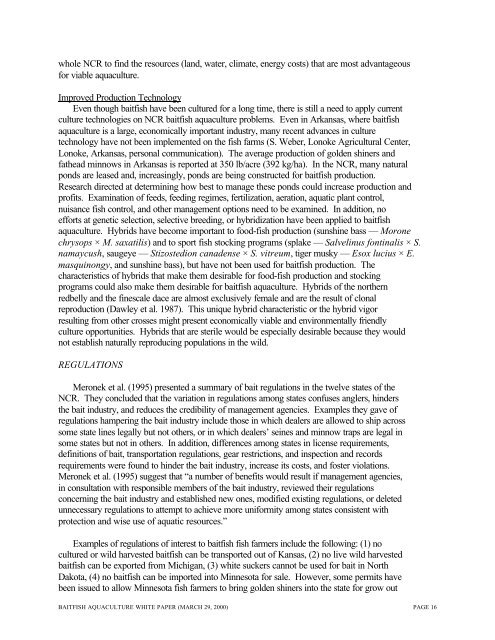a white paper on the status and needs of baitfish ... - NCRAC
a white paper on the status and needs of baitfish ... - NCRAC
a white paper on the status and needs of baitfish ... - NCRAC
You also want an ePaper? Increase the reach of your titles
YUMPU automatically turns print PDFs into web optimized ePapers that Google loves.
whole NCR to find <strong>the</strong> resources (l<strong>and</strong>, water, climate, energy costs) that are most advantageous<br />
for viable aquaculture.<br />
Improved Producti<strong>on</strong> Technology<br />
Even though <strong>baitfish</strong> have been cultured for a l<strong>on</strong>g time, <strong>the</strong>re is still a need to apply current<br />
culture technologies <strong>on</strong> NCR <strong>baitfish</strong> aquaculture problems. Even in Arkansas, where <strong>baitfish</strong><br />
aquaculture is a large, ec<strong>on</strong>omically important industry, many recent advances in culture<br />
technology have not been implemented <strong>on</strong> <strong>the</strong> fish farms (S. Weber, L<strong>on</strong>oke Agricultural Center,<br />
L<strong>on</strong>oke, Arkansas, pers<strong>on</strong>al communicati<strong>on</strong>). The average producti<strong>on</strong> <strong>of</strong> golden shiners <strong>and</strong><br />
fa<strong>the</strong>ad minnows in Arkansas is reported at 350 lb/acre (392 kg/ha). In <strong>the</strong> NCR, many natural<br />
p<strong>on</strong>ds are leased <strong>and</strong>, increasingly, p<strong>on</strong>ds are being c<strong>on</strong>structed for <strong>baitfish</strong> producti<strong>on</strong>.<br />
Research directed at determining how best to manage <strong>the</strong>se p<strong>on</strong>ds could increase producti<strong>on</strong> <strong>and</strong><br />
pr<strong>of</strong>its. Examinati<strong>on</strong> <strong>of</strong> feeds, feeding regimes, fertilizati<strong>on</strong>, aerati<strong>on</strong>, aquatic plant c<strong>on</strong>trol,<br />
nuisance fish c<strong>on</strong>trol, <strong>and</strong> o<strong>the</strong>r management opti<strong>on</strong>s need to be examined. In additi<strong>on</strong>, no<br />
efforts at genetic selecti<strong>on</strong>, selective breeding, or hybridizati<strong>on</strong> have been applied to <strong>baitfish</strong><br />
aquaculture. Hybrids have become important to food-fish producti<strong>on</strong> (sunshine bass — Mor<strong>on</strong>e<br />
chrysops × M. saxatilis) <strong>and</strong> to sport fish stocking programs (splake — Salvelinus f<strong>on</strong>tinalis × S.<br />
namaycush, saugeye — Stizostedi<strong>on</strong> canadense × S. vitreum, tiger musky — Esox lucius × E.<br />
masquin<strong>on</strong>gy, <strong>and</strong> sunshine bass), but have not been used for <strong>baitfish</strong> producti<strong>on</strong>. The<br />
characteristics <strong>of</strong> hybrids that make <strong>the</strong>m desirable for food-fish producti<strong>on</strong> <strong>and</strong> stocking<br />
programs could also make <strong>the</strong>m desirable for <strong>baitfish</strong> aquaculture. Hybrids <strong>of</strong> <strong>the</strong> nor<strong>the</strong>rn<br />
redbelly <strong>and</strong> <strong>the</strong> finescale dace are almost exclusively female <strong>and</strong> are <strong>the</strong> result <strong>of</strong> cl<strong>on</strong>al<br />
reproducti<strong>on</strong> (Dawley et al. 1987). This unique hybrid characteristic or <strong>the</strong> hybrid vigor<br />
resulting from o<strong>the</strong>r crosses might present ec<strong>on</strong>omically viable <strong>and</strong> envir<strong>on</strong>mentally friendly<br />
culture opportunities. Hybrids that are sterile would be especially desirable because <strong>the</strong>y would<br />
not establish naturally reproducing populati<strong>on</strong>s in <strong>the</strong> wild.<br />
REGULATIONS<br />
Mer<strong>on</strong>ek et al. (1995) presented a summary <strong>of</strong> bait regulati<strong>on</strong>s in <strong>the</strong> twelve states <strong>of</strong> <strong>the</strong><br />
NCR. They c<strong>on</strong>cluded that <strong>the</strong> variati<strong>on</strong> in regulati<strong>on</strong>s am<strong>on</strong>g states c<strong>on</strong>fuses anglers, hinders<br />
<strong>the</strong> bait industry, <strong>and</strong> reduces <strong>the</strong> credibility <strong>of</strong> management agencies. Examples <strong>the</strong>y gave <strong>of</strong><br />
regulati<strong>on</strong>s hampering <strong>the</strong> bait industry include those in which dealers are allowed to ship across<br />
some state lines legally but not o<strong>the</strong>rs, or in which dealers’ seines <strong>and</strong> minnow traps are legal in<br />
some states but not in o<strong>the</strong>rs. In additi<strong>on</strong>, differences am<strong>on</strong>g states in license requirements,<br />
definiti<strong>on</strong>s <strong>of</strong> bait, transportati<strong>on</strong> regulati<strong>on</strong>s, gear restricti<strong>on</strong>s, <strong>and</strong> inspecti<strong>on</strong> <strong>and</strong> records<br />
requirements were found to hinder <strong>the</strong> bait industry, increase its costs, <strong>and</strong> foster violati<strong>on</strong>s.<br />
Mer<strong>on</strong>ek et al. (1995) suggest that “a number <strong>of</strong> benefits would result if management agencies,<br />
in c<strong>on</strong>sultati<strong>on</strong> with resp<strong>on</strong>sible members <strong>of</strong> <strong>the</strong> bait industry, reviewed <strong>the</strong>ir regulati<strong>on</strong>s<br />
c<strong>on</strong>cerning <strong>the</strong> bait industry <strong>and</strong> established new <strong>on</strong>es, modified existing regulati<strong>on</strong>s, or deleted<br />
unnecessary regulati<strong>on</strong>s to attempt to achieve more uniformity am<strong>on</strong>g states c<strong>on</strong>sistent with<br />
protecti<strong>on</strong> <strong>and</strong> wise use <strong>of</strong> aquatic resources.”<br />
Examples <strong>of</strong> regulati<strong>on</strong>s <strong>of</strong> interest to <strong>baitfish</strong> fish farmers include <strong>the</strong> following: (1) no<br />
cultured or wild harvested <strong>baitfish</strong> can be transported out <strong>of</strong> Kansas, (2) no live wild harvested<br />
<strong>baitfish</strong> can be exported from Michigan, (3) <str<strong>on</strong>g>white</str<strong>on</strong>g> suckers cannot be used for bait in North<br />
Dakota, (4) no <strong>baitfish</strong> can be imported into Minnesota for sale. However, some permits have<br />
been issued to allow Minnesota fish farmers to bring golden shiners into <strong>the</strong> state for grow out<br />
BAITFISH AQUACULTURE WHITE PAPER (MARCH 29, 2000) PAGE 16


